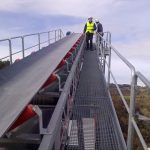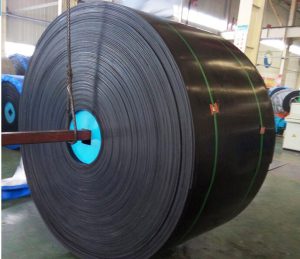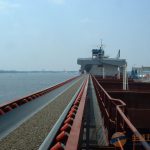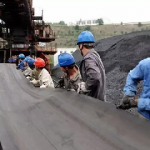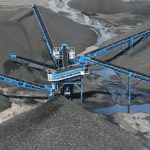The 19 Most Common Problems of Belt Conveyors, Their Causes, and Solutions:
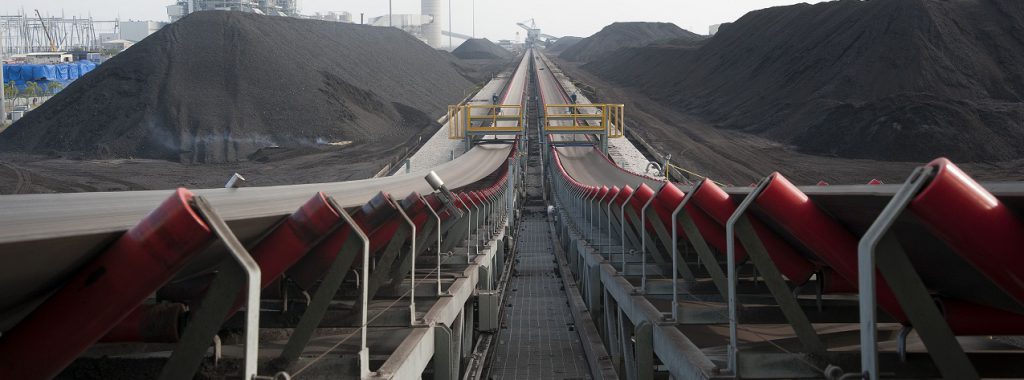
Belt conveyors are widely used in mining, metallurgy, coal, transportation, hydropower, chemical and other sectors because of their large transportation capacity, simple structure, convenient maintenance, low cost, and strong versatility. Problems with belt conveyors will directly affect production. This article shares common problems and possible causes in the operation of belt conveyors.
1. The conveyor belt runs off the tail drum
Possible reasons: a. The roller is jammed; b. The accumulation of scraps; c. Insufficient weight; d. Improper loading and sprinkling; e. The roller, roller and conveyor are not on the center line.
2. The conveyor belt runs off at any point
Possible reasons: a. Partial load; b. Accumulation of scraps; c. Improper follow-up of the roller; d. Transitional tension on one side of the conveyor belt; e. Improper loading and sprinkling; f. The roller, roller and conveyor are not on the center line. .
3. A certain part of the conveyor belt runs off at any point
Possible reasons: a. Poor performance of the vulcanized joint of the conveyor belt, improper selection of the mechanical buckle; b. Edge wear; c. The conveyor belt is curved.
4. The conveyor belt runs off the head drum
Possible reasons: a. The roller, the roller and the conveyor are not on the center line; b. The accumulation of scraps; c. The rubber surface of the roller is worn out; d. The roller is installed improperly.
5. On several specific rollers, the conveyor belt deviates to one side for the entire section
Possible reasons: a. The roller, roller and conveyor are not on the center line; b. The roller is installed improperly; c. The accumulation of debris.
6. Conveyor belt slipping
Possible reasons: a. The supporting roller is jammed; b. The accumulation of scraps; c. The rubber surface of the roller is worn; d. Insufficient counterweight; e. Insufficient friction between the conveyor belt and the roller.
7. The conveyor belt slips when starting
Possible reasons: a. Insufficient friction between the conveyor belt and the roller; b. Insufficient counterweight; c. The rubber surface of the roller is worn; d. The strength of the conveyor belt is insufficient.
8. Excessive elongation of the conveyor belt
Possible reasons: a. Excessive tension; b. Insufficient strength of the conveyor belt; c. Accumulation of scraps; d. Excessive counterweight; e. Asynchronous operation of the dual-drive drum; f. Chemical substances, acid, heat, and rough surface materials. Damage.
9. The conveyor belt is broken at or near the buckle, or the buckle is loose
Possible reasons: a. Insufficient strength of the conveyor belt; b. The diameter of the roller is too small; c. Excessive tension; d. The rubber surface of the roller is worn; e. The counterweight is too large; f. There is foreign matter between the conveyor belt and the roller; g. Double drive The drum runs asynchronously; h. The performance of the vulcanized joint of the conveyor belt is poor, and the mechanical buckle is not properly selected.
10. Fracture of vulcanized joint
Possible reasons: a. Insufficient strength of the conveyor belt; b. The diameter of the roller is too small; c. Excessive tension; d. There is foreign matter between the conveyor belt and the roller. Improper buckle selection.
11. The upper cover rubber is severely worn, including tearing, gouging, breaking, and puncturing
Possible reasons: a. Accumulation of scraps; b. Improper loading or sprinkling; c. Relative loading speed is too high or too low; d. The load has too much impact on the buckle; e. Chemical substances, acid, heat, rough surface Material damage.
12. The lower cover rubber is severely worn
Possible reasons: a. The roller is jammed; b. The accumulation of scraps; c. The rubber surface of the roller is worn; d. There is foreign matter between the conveyor belt and the roller; e. The friction between the conveyor belt and the roller is insufficient; f. Chemical substances, acid , Heat, damage caused by rough surface materials.
13. The edges of the conveyor belt are severely worn
Possible reasons: a. Partial load; b. Excessive tension on one side of the conveyor belt; c. Improper loading and sprinkling; d. Damage caused by chemicals, acids, heat and rough surface materials; e. The conveyor belt is curved; f. Accumulation of scraps; g. Poor performance of vulcanized joints of conveyor belts and improper selection of mechanical buckles.
14. There are dot-shaped and striped bubbles in the covering layer
Possible causes: damage caused by chemicals, acids, heat, and rough surface materials.
15. Conveyor belt is hardened and cracked
Possible reasons: a. Damage caused by chemicals, acid, heat, and rough surface materials; b. The roller diameter is small; c. The rubber surface of the roller is worn.
16. Overburden embrittlement and cracking
Possible causes: damage caused by chemicals, acids, heat, and rough surface materials.
17. The top cover rubber has longitudinal groove marks
Possible reasons: a. Improper installation of the side baffle; b. The roller jam; c. The accumulation of scraps; d. The load has too much impact on the buckle.
18. The bottom cover rubber has longitudinal groove marks
Possible reasons: a. The roller is jammed; b. The accumulation of scraps; c. The rubber surface of the roller is worn.
19, the roller is damaged in the groove
Possible reasons: a. The roller gap is too large; b. The slope of the variable slope point is too large.

Solutions to common problems of belt conveyors
1. The conveyor belt is curved
On the whole core conveyor belt that will not happen, pay attention to the following points for the layered belt:
a) Avoid squeezing the layered conveyor belt;
b) Avoid storing the layered conveyor belt in a humid environment;
c) When the conveyor belt is running in, the conveyor belt must be straightened first;
d) Check the entire conveyor system.
2. Poor performance of conveyor belt vulcanized joints and improper selection of mechanical buckles
a) Use a suitable mechanical buckle;
b) Re-tension the conveyor belt after running for a period of time;
c) If there is a problem with the vulcanized joint, cut off the joint and make a new one;
d) Observe regularly.
3. One side of the conveyor belt is elongated and deformed
It will not happen on the whole core conveyor belt. For other conveyor belts, pay attention to the following points: the running-in of the conveyor belt needs to be long enough. If the conveyor belt runs-in poorly or the old conveyor belt, remove the elongated and deformed part and make a new one. Connector.
4. The counterweight is too large
a) Recalculate and adjust the counterweight accordingly;
b) Reduce the tension to the critical point and fix it again;
c) If the winch is tensioned, make appropriate adjustments.
5. Insufficient counterweight
Recalculate and adjust the counterweight accordingly.
6. Damage caused by chemical substances, acids, alkalis, heat, and rough surface materials
a) Choose conveyor belts designed for special conditions;
b) Use sealed mechanical buckle or vulcanized joint;
c) The conveyor shall take measures such as rain and sun protection.
7. Asynchronous operation of dual-drive drum
Make proper adjustments to the rollers.
8. The conveyor belt is not strong enough
Because the amount of coal passing through the center point or loading point increases, or the belt speed decreases, the tension should be recalculated and a conveyor belt with suitable belt strength should be used.
9. Edge wear
Prevent the conveyor belt from deviating and remove the part of the conveyor belt with severe edge wear.
10. The roller gap is too large
Adjust the gap so that the gap between the rollers should not be greater than 10mm even when fully loaded.
11. The impact of the load on the conveyor belt and buckle is too large
a) Correctly use flow troughs and buffer plates designed according to working conditions;
b) Install anti-impact rollers;
c) If possible, load fine coal first;
d) If the side baffle does not jam coal, adjust the gap between the side baffle and the conveyor belt.
12. Rollers, rollers and conveyors are not on the center line
a) Re-alignment;
b) Install limit switches;
c) Refer to the conveyor manual.
13. Improper loading and sprinkling
a) The feeding direction and speed should be consistent with the running direction and speed of the conveyor belt to ensure that the loading point is at the center of the conveyor belt;
b) Use appropriate feeders, flow troughs and side baffles to control the flow.
14. Insufficient friction between the conveyor belt and the roller
a) Use a buffer drum to increase the wrap angle;
b) Use rubber-coated rollers;
c) Use grooved rubber roller in humid environment;
d) Install appropriate cleaning devices on the conveyor belt;
e) Check the initial tension.
15. Accumulation of scraps (on the drum and idler)
a) Install cleaners, scrapers, etc.;
b) Remove the material scraps.
16. There is a foreign body between the conveyor belt and the roller
a) Correct use of side baffles;
b) Remove foreign matter such as scraps.
17, the roller rubber surface wear
a) Replace the rubber surface;
b) Use grooved rubber surface in humid environment;
c) Deal with loose and protruding screws with rubber surface.
18. The relative loading speed is too high or too low
a) Adjust the flow trough or correct the running speed of the conveyor belt;
b) Consider using impact-resistant rollers and pay close attention to operating conditions.
The above are the common problems of belt conveyors and related solutions. In order to extend the service life of the conveyor equipment, and for the equipment to perform better production operations, it is necessary to carry out regular maintenance on the belt conveyor, so that it can truly Improve production efficiency and increase economic benefits.

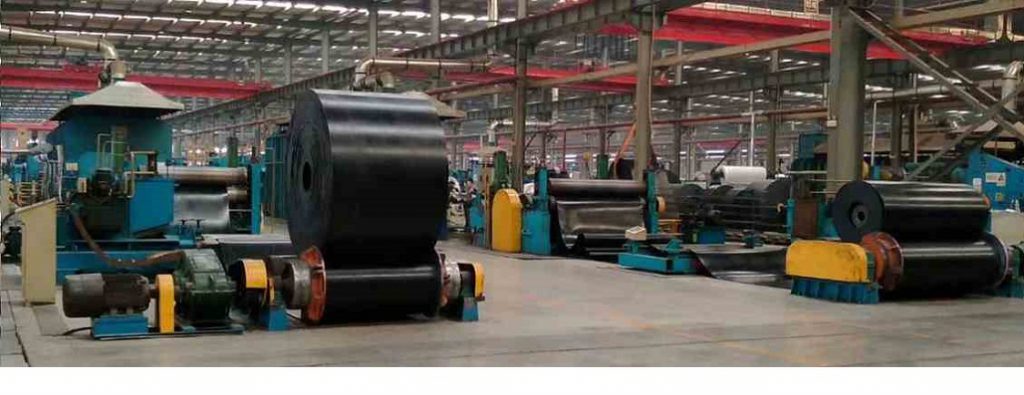
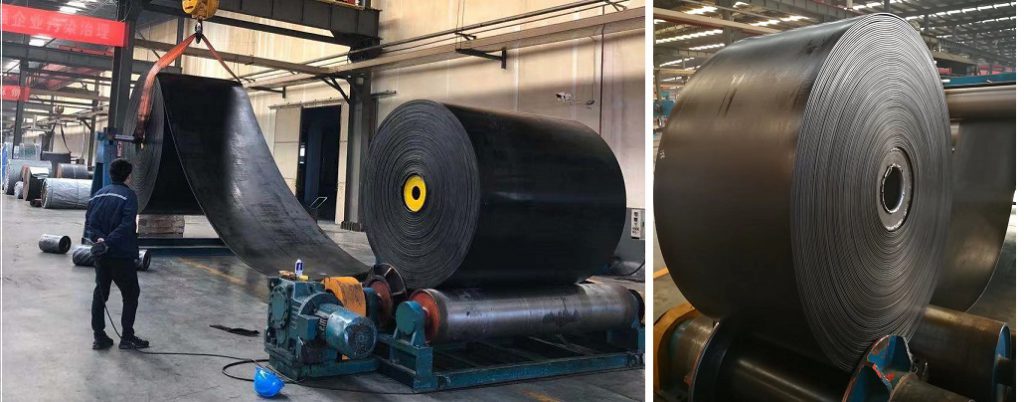



Tags: conveyor belt maintenance,conveyor system,failure

